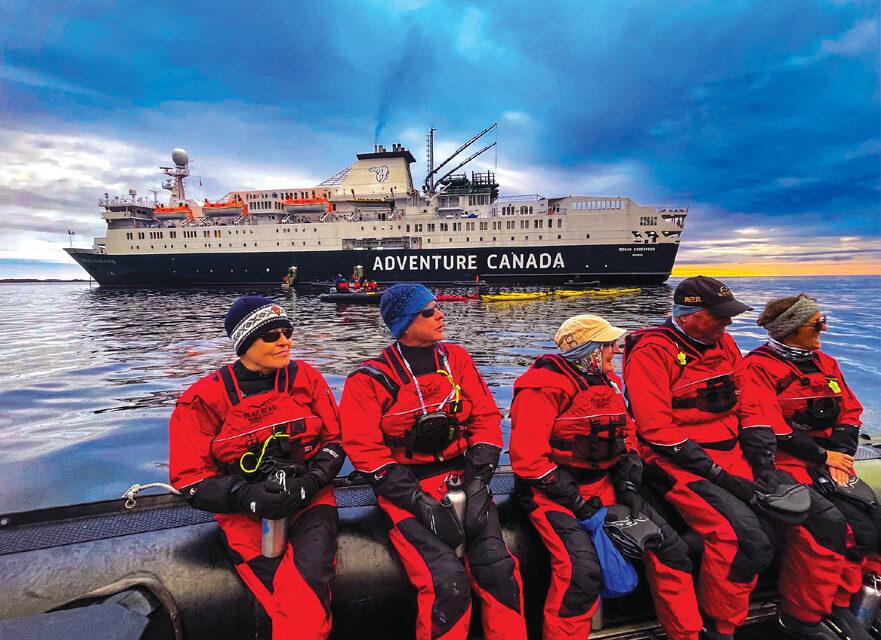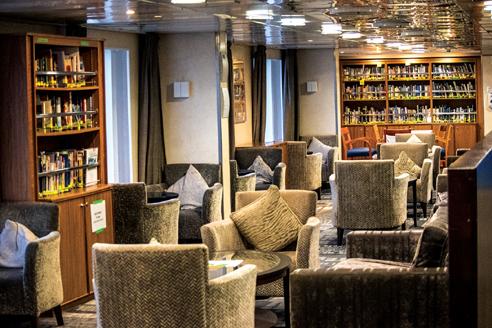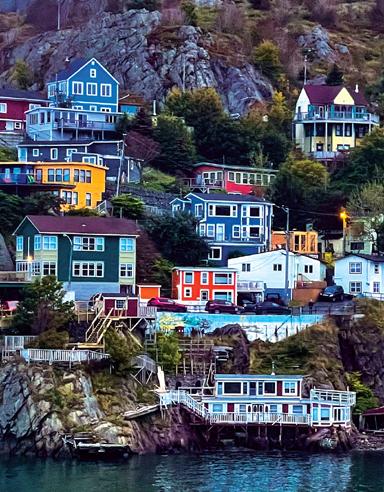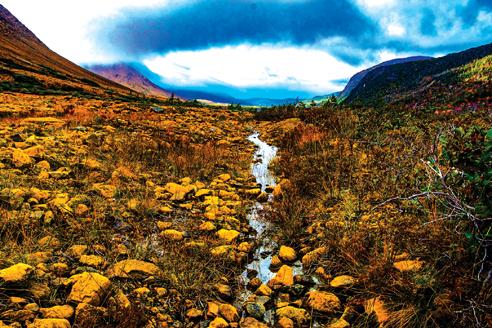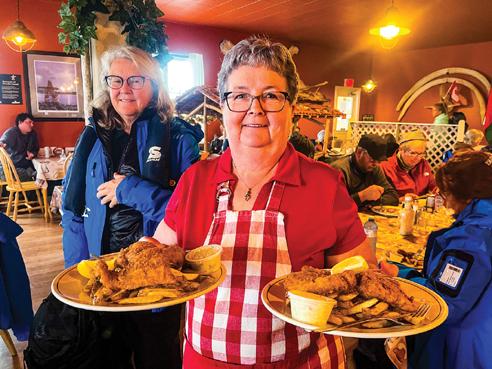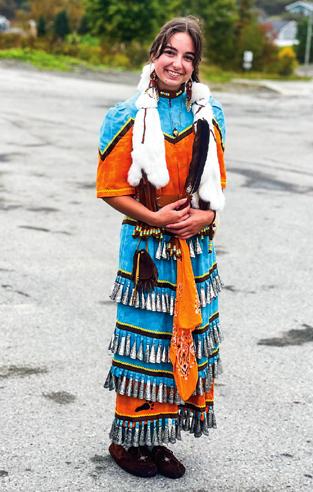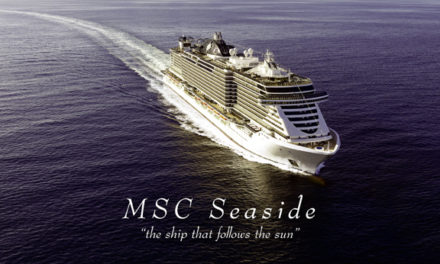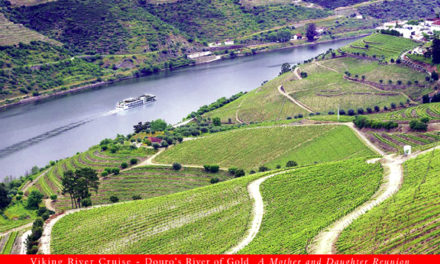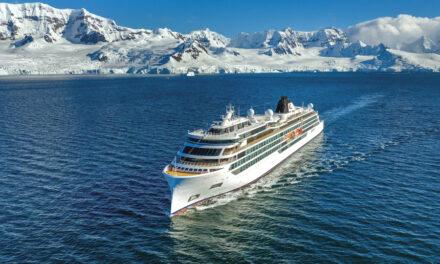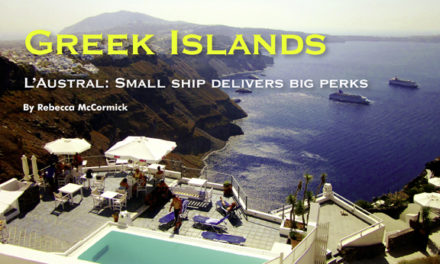Cruise
Around Newfoundland by Ship with Adventure Canada
Article and photography by Nicholas Kontis
Many television viewers, I suspect, might credit a German shepherd for what they know about Canada’s most easterly and isolated province.
In the Canadian police drama “Hudson & Rex,” a detective and his canine partner solve crimes in and around picturesque St. John’s, capital of the province of Newfoundland and Labrador. Through six seasons (including 2024), their cop work has taken them to all corners of Newfoundland, the world’s 16th-largest island; to adjacent Labrador, a sparsely populated fragment of the North American mainland; and even to the French territory of St.-Pierre-et-Miquélon, anchored just offshore Newfoundland in the Atlantic Ocean.
Not surprisingly, the real Newfoundland is very different than the one you might see on your TV screen. Locals affectionately call it “The Rock” and pronounce its name as “Noof’n-lund.” It’s larger than many nations, including the United Kingdom and New Zealand. The maritime province is constantly windy. A quarter of the island’s population (about 110,000 people) live in greater St. John’s — which like most island settlements, is built along the shore. It can be a long way by road from St. John’s to other towns, and the original European-descended colonists found they preferred boats for getting around.
Those who came before
Sea was my choice as well. One rare, sunny October day, when the wind was barely blowing, I boarded the MS Ocean Endeavour for a two-week expedition cruise around the island of Newfoundland. I couldn’t imagine a better way to explore.
We departed from and returned to St. John’s. On board were 167 guests (80 percent of them Canadians), 103 crew, and 39 expedition team members: our guides, as it were. They were mostly Canadian High Arctic experts from Toronto-based Adventure Canada, who also meander the Northwest Passage on other High Arctic small-ship expeditions.
We followed in the path of earlier explorers like Leif Eriksen, who 500 years before Columbus led a Norse-Icelandic journey to far-eastern Canada. Seeing massive rocks but no grass, they concluded the land would be useless for agriculture. When Italian John Cabot arrived in 1497, he noted the abundance of cod and the ease of casting baskets into the sea for plentiful harvests of the salty fish. That inspired fishing settlements. By the early 1800s, a forestry industry was thriving; many locals today have ancestors who worked in island sawmills.
Our expedition lecturers shared background like this each morning and again before dinner each evening. “You’re in for a real treat,” Endeavour leader Scott McDougall told us on the first day. “Few places can boast the stark, wild beauty and warm hospitality found in Newfoundland.”
Our host for the journey was Newfoundland native Dennis Minty, an eco-guide, photographer and naturalist since 2002. Tony Oxford, another native son, served as “cultural educator”; the onetime mayor of tiny Cox’s Cove composed his own music for nightly jam sessions and enthralled us with daily talks on dozens of subjects. An example was his description of the island’s unique, Gaelic-affected English dialect. Should someone (such as Oxford himself) offer the greeting “Whadda y’at?” he said, the proper response is: “This is it!”
It was a real treat to have Chief Mi’sel Joe, the hereditary and spiritual leader of the Mi’kmaq people of Newfoundland and Labrador on board. Joe is a master storyteller and the author of numerous literary works about his people. He and co-author Shiela O’Neill, a distant relative, taught us about Aboriginal culture. “It’s so important that we tell our own story, because nobody else is going to do it,” Chief Joe emphasized.
Highlights of the voyage
Our first stop was at Terra Nova (“New World”) National Park. Tourism is restoring a degree of life to the remote fishing village of Conche, which like many other communities was decimated by a 1992 Canadian government moratorium on cod fishing. A short hike from the settlement of 250 people leads to a restored lighthouse and a waterfall, as well as the Glass Hole, a stunning granite cavern with a jagged window on the Atlantic. We were thrilled when locals served us a meal in their community hall, complete with song and dance.
L’Anse aux Meadows is the only confirmed archeological site of Norse settlement on the North American continent. A UNESCO World Heritage site, it dates from the 11th century but was only excavated in the 1960s. Daily reenactments of ancient life are offered among the remains of eight buildings, built of sod over wooden frames. More than 800 Viking objects, including Iron and Bronze Age artifacts, have been unearthed here at the northernmost tip of Newfoundland island.
On the Labrador mainland, we made a lone stop at Red’s Cay, a former Basque whaling port. The local museum showcases the wreck of a whaling boat more than 400 years old, along with tools and navigational instruments. We lunched at the Whalers Restaurant, which served some of the best fish and chips I’ve ever had.
Gros Morne National Park ís another UNESCO site, acclaimed for its unique geology and population of moose. It is crowned by The Tablelands, Newfoundland’s second-highest elevation, which appear desert-like but also contain a forested area. Woody Point, an alluring town in the heart of the park, has many historical waterfront buildings.
Cox’s Cove, Tony Oxford’s village, is another significant fishing and lodging community. We hiked to a waterfall and plunged into the frigid water at its foot for (in my case a very quick dip. Later in the day at the abandoned settlement of Brake’s Cove, I went kayaking while my fellow expeditioners enjoyed a beach barbecue of mussels, fish and local beer.
On an educational stopover at Chief Joe’s Miawpukek First Nation on the Conne River, we enjoyed a vísit to the Ta’n etl-Mawita’mk Community Center. Here Mi’kmaq elders told us about their history, and young people performed traditional songs and dances.
Our final stopover before returning to St. John’s was the charming island of St. Pierre. To this day, the domain remains distinctly French, a self-governing overseas territory of France. As such, we had to produce our passports.
In particular, I was pleased to pay a small premium to join 10 other guests in sea-kayaking expeditions. Led by guides Barb and Cathy, we glided through pristine bays and past picturesque shorelines, viewing landscapes and settlements by the sea.
Weather permitting
“Go with the flow while we attempt to stick to a set itinerary,” recommended Scott McDougall, our expedition leader. “That’s not always the case,” he warned. “It means that no two journeys will ever be the same.”
Ultimately, weather plays a leading role in expedition sailings. During evening briefings, the first matter of the coming day is how the weather will be. While not as unpredictable as in polar regions, Newfoundland weather can quickly change from sun to thunderstorms. Heavy winds might be in the forecast at your next destination, canceling a scheduled stop. Changes in plans mean that each individual experience will never be duplicated.
How one adapts to change will affect the outcome of any expedition. On this October cruise, inclement weather nearly caused us to miss a stop at picturesque Francois. Yet the Endeavour’s relatively small size, with a capacity of under 200 passengers, made it possible to navigate a new course. Zodiac craft transported guests to shore, giving us a rare opportunity to experience a choppy ride on big waves in a rough sea.
Travelers, not tourists
Adventure Canada is the exclusive polar provider of the Explorers Club, founded in 1904. Notable explorers and scientists may be among the passengers on any expedition.
Expedition cruising is one of the fastest-growing sectors in travel. Sustainable, responsible travel, and an interest in protecting the environment, are no longer just buzzwords. With a commitment to regenerative tourism, Adventure Canada’s Newfoundland Circumnavigation teaches about the rich tapestry of cultures while treading lightly on lands, preserving flora and fauna. New routes are on the minds of cruise lines and on travelers’ radar, making off-the-beaten-path Newfoundland ripe for greater exploration.
Adventure Canada is a small-ship expedition cruise line. Unforgettable encounters shepherded by a stellar expedition team who showcase their expertise in culture, history, indigenous people, photography, geology, marine biology, flora, fauna and music. Many are native Newfoundlanders who bring their culture on board.
Refurbished in 2015, the well-appointed Ocean Endeavour offers comfort and stability similar to newer ships. Our 13-day circumnavigation of Newfoundland covered 1,225 nautical miles and 150 hours at sea. We learned a fascinating history while lightly treading its pristine land.
Travel changes us like nothing else. As Dennis Minty told guests in an early lecture: “The tourist arrives at a destination perhaps seeking familiarity, a McDonald’s or maybe an all-inclusive hotel. You all came on this expedition with an open mind and a thirst to learn because you’re travelers. You want to venture off the beaten path, eat and drink with locals, and immerse yourself in the culture and land.”
Indeed, I came to celebrate this unique land’s people, sights, sounds and folklore. Keeping it local, I channeled Tony Oxford’s greeting, “Whadda y’at?” and, of course, my reply, “This is it.”

